Music by: Ian Michael Augustine - "The Emerald Tablet"
The middle path of Virtue is the mean between the extremes. It represents the points in common, the over-lapping magisteria of the Venn Diagram. Overlapping science and religion is a a third category of which both partake: the ancients called this third way "Philosophia," meaning "The Love of Wisdom." All three paths are mutually overlapping a fourth and final thing which all share in common: the pursuit of Truth [Lat: "veritas]. Philosophers pursue their courtship of Truth via Platonic Eros, science by means of building an accurate map [Grk: "logos"] of human knowledge [Lat: "scientia"], and religion by seeking (re)union [Lat: "religio"] with Truth through a variety of means, some of which are not altogether unlike Platonic Eros. By choosing the mean between the extremes you harmonize the opposites, creating balance and homeostasis, which leads to flourishing [eudaimonia].
You may now proceed to the Inner Sanctum...
"To be temperate is the greatest virtue. Wisdom consists in speaking and acting the Truth, giving heed to the nature of things." - Heraclitus, Fragment 112 Excerpt from: "What is Ancient Philosophy?" Pierre Hadot, Harvard University Press, 2002
Suggestions for Further Reading:
"Aristotle, Virtue and the Mean: Introduction" Janet D. Sisson, Apeiron: A Journal for Ancient Philosophy and Science, Vol. 28, No. 4, ARISTOTLE,VIRTUE AND THE MEAN (December 1995), pp. vii-xxi "The Practical Import of Aristotle's Doctrine of the Mean" J.E. TilesSource: Apeiron: A Journal for Ancient Philosophy and Science, Vol. 28, No. 4, ARISTOTLE,VIRTUE AND THE MEAN (December 1995), pp. 1-14 "Homeostasis and the Mean in Aristotle's Ethics" Janet D. Sisson, Apeiron: A Journal for Ancient Philosophy and Science, Vol. 28, No. 4, ARISTOTLE,VIRTUE AND THE MEAN (December 1995), pp. vii-xxi "Aristotle's 'Right Reason (Orthos Logos)'" Alfonso Gómez-Lobo, Apeiron: A Journal for Ancient Philosophy and Science, Vol. 28, No. 4, ARISTOTLE,VIRTUE AND THE MEAN (December 1995), pp. 15-34 "Aristotle's Doctrine That Virtue Is a 'Mean'" W. F. R. Hardie, Proceedings of the Aristotelian Society, New Series, Vol. 65 (1964 - 1965), pp. 183-204 "Knowledge and Unity in Heraclitus" Patricia Kenig Curd, The Monist, Vol. 74, No. 4, Heraclitus (OCTOBER 1991), pp. 531-549 "The Logos of Heraclitus" Edwin L. Minar, Jr., Classical Philology, Vol. 34, No. 4 (Oct., 1939), pp. 323-341 "The Logos of Heraclitus: Updating the Report" Ed. L. Miller, The Harvard Theological Review, Vol. 74, No. 2 (Apr., 1981), pp. 161-176 "Heraclitus and Fire" Constance I. Smith, Journal of the History of Ideas, Vol. 27, No. 1 (Jan. - Mar., 1966), pp. 125-127 "The Plotinian Logos and Its Stoic Basis" R. E. Witt, The Classical Quarterly, Vol. 25, No. 2 (Apr., 1931), pp. 103-111 "Plato's Theory of Eros in the Symposisum" Gerasimos Santas, Noûs, Vol. 13, No. 1 (Mar., 1979), pp. 67-75 "Sorcerer Love: A Reading of Plato's Symposium, Diotima's Speech" Luce Irigaray and Eleanor H. Kuykendall, Hypatia, Vol. 3, No. 3, French Feminist Philosophy (Winter, 1989), pp. 32-44 "The Concept of Love in Plato" Paulette Marie Zych, Social Science, Vol. 53, No. 3 (SUMMER 1978), pp. 133-138
